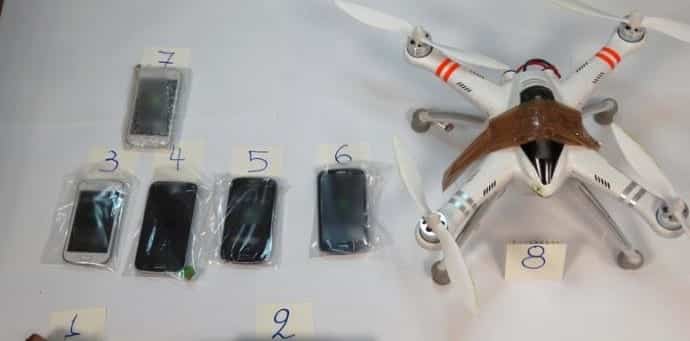Criminals using drones to smuggle drugs, phones into prison
It has been revealed that drones that are used for capturing some breath-taking footage is now being used by Criminals to smuggle drugs, mobile phones and other banned items into prisons.
According to the data obtained through the Freedom of Information (FoI) request, it showed that drones were used as much as 33 times in 2015 to smuggle banned items to prisoners, which saw an increase of 1,550% from just two cases in the year 2014. However, there were no recorded incidents in 2013. Items discovered include just the drones themselves, drugs, mobile phones and chargers, and USB drives.
Mike Rolfe, national chairman elect of the Prison Officers Association (POA), said: “The use of drones to smuggle traditional drugs, NPS (legal highs) and mobiles phones into prisons is of serious concern to the POA.
“The POA have long pushed for increased staffing resource to tackle the security issue that drones present. The additional resource should be used to increase operational staffing within establishments, allowing for the recovery of parcels delivered to prisoners by drones through cell checks and prisoner searches.
“This includes pressing NOMS (National Offender Management Service) for measures to tackle drones such as ground patrols and secure windows on cells.
“The use of illicit mobiles phones allows for increased criminal activity and distress to victims and their families.
“The trafficking of illegal drugs and legal highs hampers rehabilitation breeding violence, bullying and gang culture. All of these issues are on the increase with the use of drones supporting this criminality.”
The use of drones first made headlines in 2014 when prison officials discovered a drone carrying marijuana and a mobile phone caught in power lines outside the South Carolina jail.
Director of the South Carolina Department of Corrections Bryan P. Stirling said an investigation into the finding led law enforcement to a nearby campground where they discovered the accomplice.
“They were sending in smaller amounts in repeated trips,” he told New York Times.
“They would put it on there, they would deliver it, someone inside would get it somehow, and they would send it back out and send more in.”
The method saw an increase in popularity the following year with a string of highly publicised incidents due to the cheap availability of drones.
A drone had successfully delivered a package containing tobacco, marijuana and enough heroin for 100 doses into the recreational yard of an Ohio prison. The trick was spotless and went undetected by prison guards. It came to light only when prisoners started fighting over the ownership of the package.
Two men in the same month were arrested after a drone containing drugs, tobacco, and pornography was discovered on the rear passenger seat of a Ford pick-up truck parked outside Cumberland state prison.
In October, another drone carrying mobile phones, drugs, hacksaw blades, and superglue was discovered after cutting a razor wire fence, losing control and crashing into an Oklahoma prison.
The problem is not exclusive to the United States even Australia has also had its own problems with drones after a drone was found over Goulburn jail in December last year.
A spokesman for the NSW Department of Corrective Services said an officer in a tower saw the drone 100 metres above the main part of the prison.
“The officer moved out of the tower along the catwalk towards the drone, which flew away from the
prison until it was no longer visible. Officers searched the prison and nothing was found,” he told the ABC.
David Elliott, Minister of Corrective Services said the events did not come as a surprise.
“Technology is getting better, prisoners are getting access and the criminal element is getting access to that technology,” he said.
In 2015 alone, Mr Elliot said there were six cases of drones flying over prisons in NSW.
“That is six too many. I need the authority to make sure the community knows this is an illegal activity and I need the authority to make sure prison operators know that they can act within the law,” he said.
Research associate at the Urban Institute Bryce Peterson said the problem was under control for the time being despite these alarming cases.
“I would say it’s definitely not that widespread a problem right now,” he told Vox.
“But it certainly seems like, down the road, this is something that could become a huge problem.”
However, Mr Peterson confesses he could be wrong, because his comments are based on the cases brought to the public attention.
“It’s really hard to say how often it’s happening, because most facilities don’t have adequate systems to stop drones from coming in yet,” he said.
“So the only times you get a report are when people see a drone flying around or if it crashes.”
